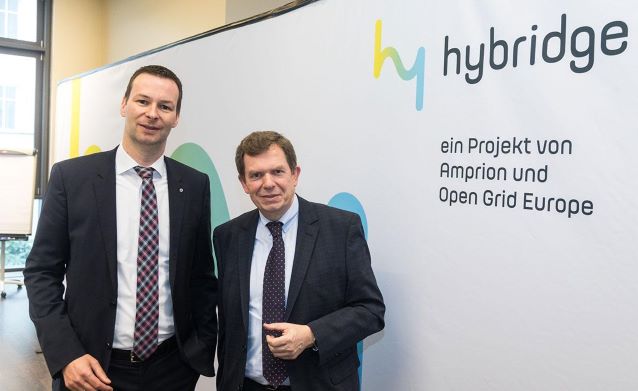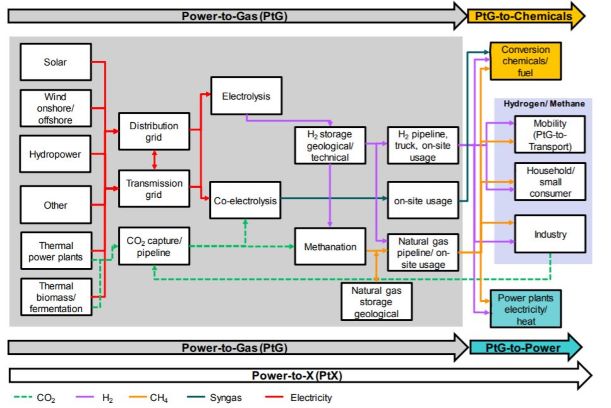

Dr. Thomas Hüwener, Open Grid Europe, Dr. Klaus Kleinekorte, Amprion (Lto R)
German power grid operator Amprion and gas grid operator Open Grid Europe (OGE) are planning to build a 100 megawatt (MW) power-to-gas plant along with hydrogen infrastructure, a project they have dubbed “hybridge”. With their “hybridge” project, Amprion and Open Grid Europe (OGE) are ready to start sector coupling at system level in Germany.
“We have now progressed to a stage where we can start the planning approval process for hybridge,” said Dr Thomas Hüwener, Member of the Board of Management of OGE. “But we still need the go-ahead from political decision-makers.” This must now come quickly, Hüwener added, so that sector coupling at system level can play its part in achieving the Paris climate targets.
[related_post]
Dr Klaus Kleinekorte, the Chief Technical Officer of Amprion, said: “Germany’s climate targets, the nuclear phase-out and the looming coal phase-out pose an enormous challenge for our energy system. We must, therefore, act now to create the prerequisites for power-to-gas to be available on a gigawatt scale after 2030 and for sector coupling to be possible at system level.”


Both the companies have even zeroed in on a location for the pilot. At an intersection between the Amprion and OGE networks in the district of Emsland the project partners have found the ideal site for the first power-to-gas (P2G) plant of this size, in which electricity from renewable sources will be converted into green hydrogen and partly into green methane via an electrolyser. Apart from the 100MW electrolyser, the project partners intend to also convert an existing OGE pipeline into a dedicated hydrogen pipeline. The partners expect project cost to be around €150 million.
Thomas Hüwener explained: “In Lingen we have ideal conditions for building a hydrogen network. There are companies that can use the hydrogen directly, and there is also a hydrogen filling and loading station in the region.” The project partners already had a constructive dialogue with the city of Lingen and the district of Emsland. Hüwener continued: “In the medium to long term, the natural gas storage facilities in this the region can also be used for hydrogen storage. Part of the existing gas transmission system can also be dedicated to hydrogen. In the future, further parts of the gas infrastructure will be converted to allow transportation of hydrogen to the Ruhr area and beyond. We can also inject small quantities of hydrogen directly into the natural gas grid or convert the hydrogen to methane, which could then be fed into the natural gas pipeline system without any restrictions.”
According to research, almost 16 countries in Europe have demonstration P2G projects, with their focus on the usage of hydrogen other than storing and using for renewable electricity. The main application for P2G plant is the injection of hydrogen or methane into the natural gas grid for storing electricity from variable renewable energy sources. Producing fuels for transport is another important application of such projects. In future, these projects are projected to get more importance from refineries to lower the carbon foot print of the products.
Picture credit: Sciencedirect.com
1. The mandate for blending Compressed Biogas (CBG) with natural gas has come into effect…
Andhra Pradesh is striving towards greening its energy sector with quite some speed. In a…
With an objective to bolster India’s green energy goals, a Tripartite Agreement has been signed…
The Union MNRE Minister Pralhad Joshi launched the Green Hydrogen Certification Scheme of India (GHCI)…
India’s energy conglomerate Bharat Petroleum Corporation Limited (BPCL) has commissioned a 5MW green hydrogen plant…
In a historical development, the European Space Agency (ESA) has successfully launched its pioneering ‘Biomass’…